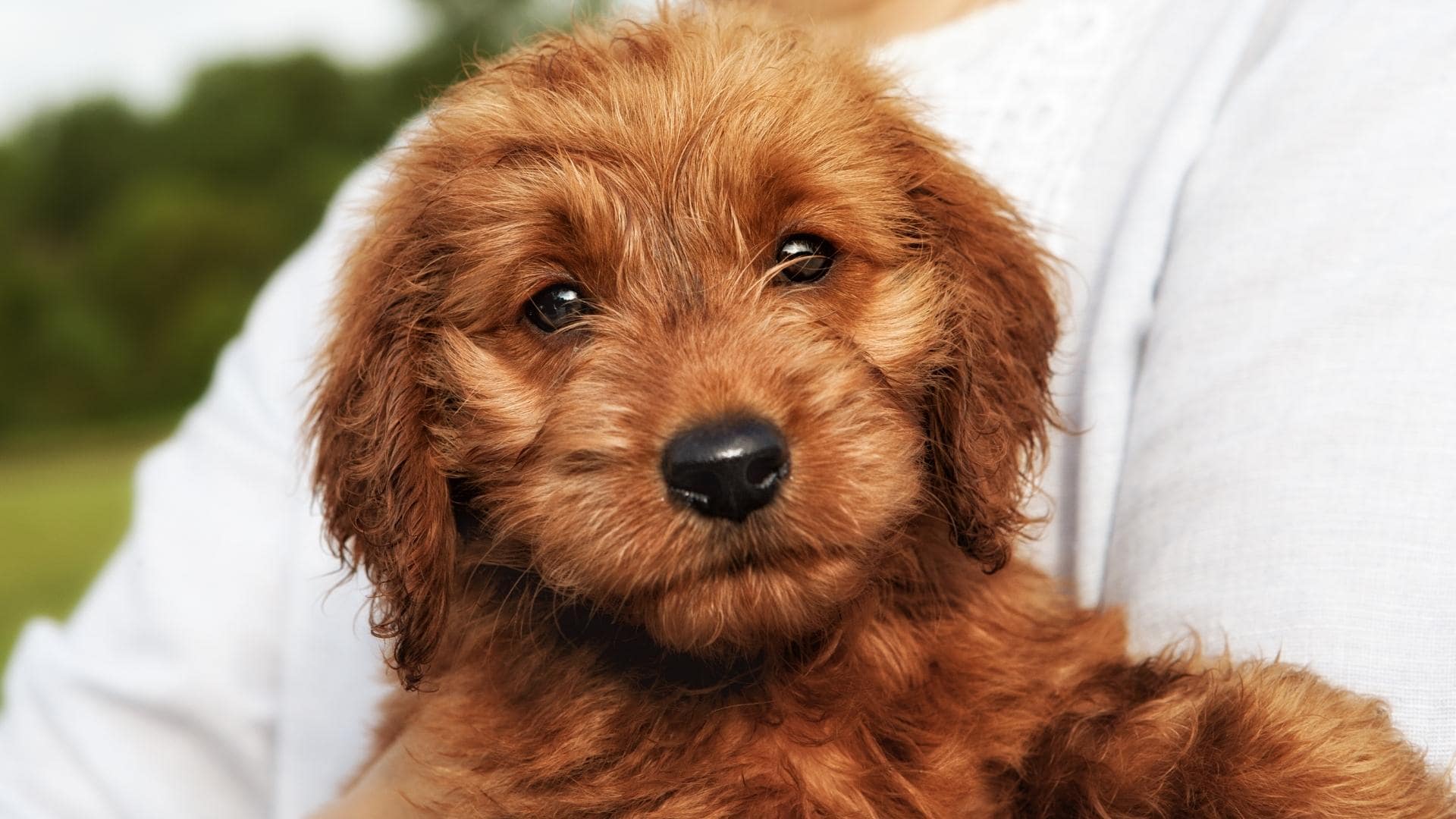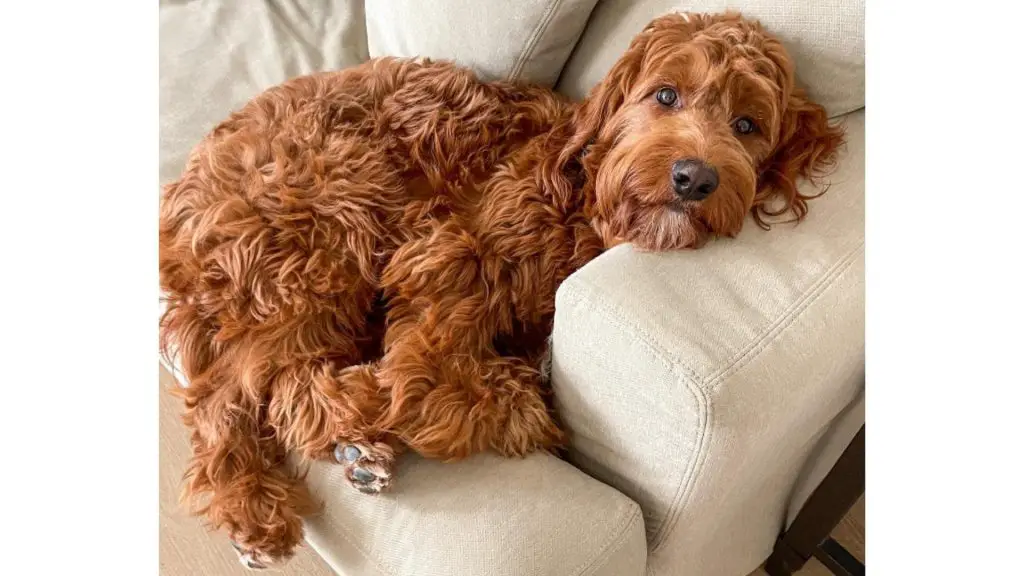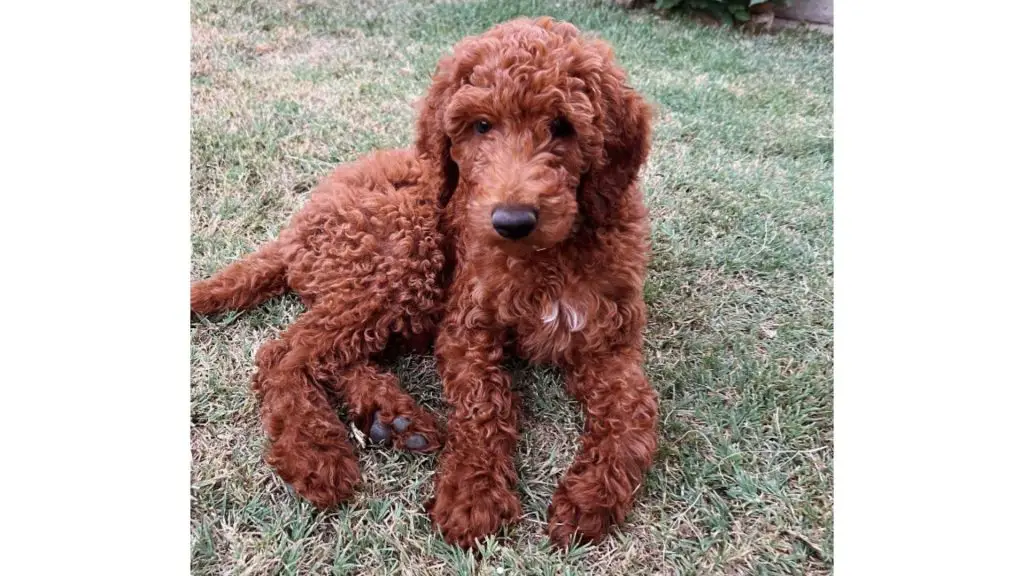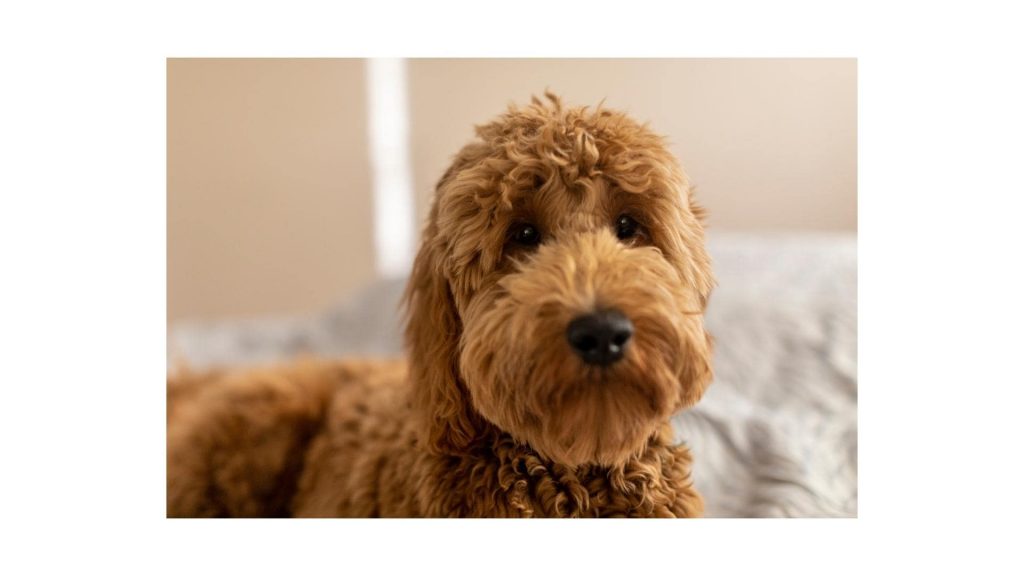Pawscessories is reader-supported. When you buy via links on our site, we may earn an affiliate commission at no cost to you.
Learn more.
Do you have a soft spot for wavy-haired dogs with a reddish hue? If so, the red Goldendoodle just might be the perfect pup for you.
This post will provide an in-depth look at everything you need to know about these lovable pups, from their physical characteristics and temperament to the size and coat color variations you might encounter.
Plus, we’ll take a look at some of the more frequently asked questions about red Goldendoodles in general.
So if you’re considering adding one of these cuties to your family, read on to discover everything you need to know about them.
Table of Contents

What Is a Red Goldendoodle?
Red Goldendoodles are a popular crossbreed of Golden Retrievers and Standard Poodles. While they inherit the best traits of both breeds, they also have a vibrant coat of red hair.
This unique color can be traced back to a single pup born in the 1970s, and today there are many different red Goldendoodle lines.
In addition to their eye-catching appearance, red Goldendoodles are known for being intelligent, friendly, and eager to please. They make excellent family pets, and with regular grooming, their coat will stay soft and shiny.
Is The Red Goldendoodle Recognized By The AKC?
The AKC does not currently recognize the red Goldendoodle as a distinct breed, but it is possible that this may change in the future. The red Goldendoodle is a relatively new hybrid breed and still developing standardized characteristics.
As more red Goldendoodles are bred, and more information becomes available about this unique variety, the AKC may eventually choose to recognize them as a separate breed.
Do Red Goldendoodles Get Lighter As They Age?
One of the most common questions about red Goldendoodles is whether or not their coat will lighten as they age.
The answer to this question is somewhat complicated, as it can vary depending on the specific line of red Goldendoodles.
Depending on how dark or light red their coat is will impact whether their coat gets lighter as they get older.
Some red Goldendoodles may lighten a few shades, while others may stay relatively the same.
Generally, if they have a lighter red coat as a puppy, they won’t get noticeably lighter as they age. Whereas if they have a dark, dark red coat as a puppy, they may get lighter with age.
But this doesn’t necessarily happen with every red Goldendoodle.
F1b Red Goldendoodle Vs. F1 Red Goldendoodle

When looking for a red Goldendoodle, you may come across the terms “F1b” or “F1.” These refer to the generation of red Goldendoodles, with “F1” meaning first-generation and “F1b” meaning second-generation.
So, an F1 red Goldendoodle would be 50% Golden Retriever and 50% Standard Poodle, while an F1b red Goldendoodle would be 75% Poodle and 25% Golden Retriever.
This is because an F1b red Goldendoodle is a mix of a purebred red Poodle and an F1 red Goldendoodle.
The difference in generation can impact the coat type, size, and temperament of the red Goldendoodle.
For example, F1 or first-generation red Goldendoodles may have a higher percentage of Golden Retriever in them and, as such, may be more likely to shed.
Meanwhile, F1b or second-generation red Goldendoodles will have a higher percentage of Poodle and may be less likely to shed.
When it comes to size, F1 red Goldendoodles are typically larger than F1b Goldendoodles.
In terms of their temperament, there is no real difference between the generations of red Goldendoodles.
Apricot Vs Red Goldendoodle
When looking at pictures of Goldendoodles, you may notice that some have a coat that is more apricot in color, while others are a true red.
So what’s the difference between an apricot Goldendoodle and a red Goldendoodle?
The simple answer is that an apricot Goldendoodle is a red Goldendoodle with a coat that is lighter in color.
Apricot Goldendoodles can range in color from a light peach to a deep reddish-orange.
Whereas red Goldendoodles will have a coat that is more red, brown, or mahogany in color.
The difference between these two colors can be subtle, and sometimes it can be hard to tell them apart.
In general, apricot Goldendoodles are less common than red Goldendoodles.
Red Goldendoodle Appearance & Traits

Size (Weight & Height)
Red Goldendoodles can range in size from toy (under 20 pounds) to mini (20-35 pounds) to standard (50-90 pounds).
The height of a red Goldendoodle can also vary depending on the size, with toy and mini red Goldendoodles typically being between 10-17 inches tall and standard red Goldendoodles being between 17-24 inches tall.
Coat Variations, Markings & Texture
When it comes to their coat, red Goldendoodles can have a variety of different coat types, textures, and lengths.
The most common coat types for red Goldendoodles are the straight coat, wavy coat, and curly coat.
The straight coat is the least common of the three and is typically seen in first-generation red Goldendoodles.
The wavy coat is more common and is seen in both first and second-generation red Goldendoodles.
The curly coat is the most common coat type for red Goldendoodles. It is seen more in second-generation or higher red Goldendoodles.
When it comes to coat texture, red Goldendoodles typically have a soft, silky coat.
Shedding & Grooming
Red Goldendoodles can range from low-shedding to non-shedding, depending on the generation and coat type.
First-generation red Goldendoodles (F1) or those with straighter coats are more likely to shed. In contrast, second-generation (or higher) red Goldendoodles or those with a curly coat are more likely to be non-shedding.
Regardless of shedding, all red Goldendoodles will need to be brushed regularly and groomed every few months.
This is because their coats can become matted and tangled if they are not brushed and groomed on a regular basis.
When it comes to the other areas of grooming, like bathing, nail trimming, and teeth cleaning, they require a similar amount of attention as other dogs.
But they will need a little more maintenance when it comes to ear cleaning.
This is because their long, floppy ears can trap dirt, wax, and moisture, which can lead to ear infections if they are not cleaned regularly.
Are Red Goldendoodles Hypoallergenic?
While red Goldendoodles are not technically hypoallergenic, they are considered to be low-shedding or non-shedding. Which means that they are less likely to trigger allergies in people who are allergic to dogs.
This is because the Poodle coat is what is known as a “single coat,” meaning that it does not have an undercoat.
The lack of an undercoat means less hair is shed, which in turn means less dander (dead skin cells) being released into the air.
Ears & Tail
The shape and size of Red Goldendoodles’ ears can vary depending on the generation.
First-generation red Goldendoodles (F1) typically have smaller, pointier ears and second-generation or higher red Goldendoodles typically have larger floppier ears.
Their tail is usually straight and medium in length, but it can also be curled.
Eye Color
Red Goldendoodles can have a variety of different eye colors, including brown, blue, green, hazel, and even two-toned eyes.
However, the most common eye color for red Goldendoodles is brown.
Lifespan

The average lifespan of a red Goldendoodle is 10-15 years.
However, this can vary depending on the size, with smaller red Goldendoodles typically living longer than larger ones.
Common Health Issues
While red Goldendoodles are generally healthy dogs, there are a few health conditions that they are more prone to than others.
Some of the more common health issues seen in red Goldendoodles include hip dysplasia, elbow dysplasia, ear infections, von Willebrand’s disease, bloat, and allergies.
It is important to note that not all red Goldendoodles will experience these health problems, but it is important to be aware of them.
If you are considering getting a red Goldendoodle, be sure to talk to a veterinarian about their potential health risks and how to best avoid them.
Trainability & Intelligence
Red Goldendoodles are considered to be highly intelligent dogs.
This means that they are typically easy to train and pick up on new commands and tricks relatively quickly.
However, it is important to note that every dog is different, and some red Goldendoodles may be more stubborn than others.
When it comes to training, it is important to use positive reinforcement methods such as rewards and praise. This will help them stay motivated and eager to learn new things.
Activity Level & Exercise Needs
Red Goldendoodles are considered to be high-energy dogs.
This means they need a fair amount of exercise to stay healthy and happy.
Ideally, red Goldendoodles should get at least 45 minutes of exercise per day, but this can vary depending on the individual dog’s activity level.
There are a variety of different ways to exercise red Goldendoodles, including walks, runs, hikes, swimming, and playing fetch.
Also, because they are such bright dogs, they need plenty of mental stimulation as well.
This can be in the form of obedience training, puzzle toys, and even simple games such as hide-and-seek.
Overall, red Goldendoodles are active dogs that need a fair amount of exercise and mental stimulation to stay happy and healthy.
Temperament & Behavior

Do Red Goldendoodles Bark A Lot?
Red Goldendoodles are generally considered to be quiet dogs.
However, this can vary depending on the individual dog, as some red Goldendoodles may bark more than others.
If you are looking for a red Goldendoodle that is less likely to bark, it is important to talk to the breeder about the temperament of the parents and puppies.
Also, because they are intelligent dogs, they can be taught to be quieter if their barking becomes too much.
Do Red Goldendoodles Like To Cuddle?
Yes, red Goldendoodles typically enjoy cuddling and being close to their owners.
This is one of the reasons why they make such great companion dogs.
Are Red Goldendoodles Good With Kids?
Red Goldendoodles are typically good with kids as they are usually gentle and patient dogs.
However, it is important to note that every dog is different, and some red Goldendoodles may not do well with kids.
If you have small children, it is important to socialize red Goldendoodles with kids from a young age so that they are comfortable around them.
It is also important to teach kids how to play nice with them as well.
Are Red Goldendoodles Good With Other Dogs?
Red Goldendoodles are typically good with other dogs as they are usually social and friendly.
However, socialization is still important for these dogs. They should be introduced to as many well-behaved dogs while young as possible.
This will help ensure they are comfortable and confident around other dogs as they grow up.
Are Red Goldendoodles Good With Strangers?
Yes, red Goldendoodles are typically good with strangers.
However, this is largely dependent on their experiences with people when young.
If they are socialized with a lot of different people from a young age, they will likely be more pleasant around strangers.
On the other hand, they may be shyer and reserved around them if they are not around people often.
Are Red Goldendoodles Good Apartment Dogs?
It depends on the size of the red Goldendoodle.
Standard red Goldendoodles may not be well suited for apartment living as they are medium-sized and need a fair amount of exercise.
However, the miniature and toy-size red Goldendoodles do better in apartments as they are smaller and don’t need as much exercise.
Regardless, each dog, no matter their size, needs exercise and mental stimulation to ensure they don’t become bored and destructive while living in an apartment.
Food & Diet
Red Goldendoodles should eat a high-quality diet that is appropriate for their age, activity level, and health condition.
The best way to determine what type of food is best for your red Goldendoodle is to talk to a veterinarian.
They can help you choose a food that meets your dog’s individual needs.
Red Goldendoodles typically should eat two to three meals per day.
Puppies under six months old should eat three times per day, while adults can usually get by on two meals.
However, this can vary depending on the individual dog and their activity level.
Red Goldendoodle Puppy Price

The price of a red Goldendoodle puppy can vary depending on the breeder, their location, the puppy’s size, and other factors.
However, you can expect to pay anywhere from $900 all the way up to $3000 for a red Goldendoodle puppy.
It is important to do your research when looking for a breeder and to ensure that you are getting a healthy puppy.
There are a lot of things to consider when choosing a red Goldendoodle puppy.
Size, coat color, markings, and temperament are all important factors to take into consideration.
You also need to make sure that you find a reputable breeder who can provide you with a healthy puppy.
Where Can You Find Red Goldendoodles For Sale?

There are many places to find red Goldendoodles for sale.
You can find them at local breeders, online breeders, and even shelters and rescues.
When looking for a breeder, always visit the facility and meet the puppies in person before making a decision.
This will help you ensure that you are getting a healthy puppy and that the breeder is reputable.
If you don’t have any local Goldendoodle breeders that have red-coated puppies available, you can also look at online breeder directories.
These websites allow breeders from all across North America to list their puppies for potential owners to look at. Now, it’s still important to do your own research to ensure the breeders you reach out to are reputable, but it’s a good place to start.
A few more established breeder directory websites are AKC’s Marketplace, Lancaster Puppies, and Greenfield Puppies.
These sites have Goldendoodles listed, and there’s a good chance there will be a red one available. Whether it’s in your city or within driving distance isn’t guaranteed, though.
Final Thoughts
Red Goldendoodles are beautiful and unique dogs. They are known for their friendly temperament, intelligence, and loyalty.
If you are looking for a dog that will be a loving family pet, then the red Goldendoodle may be the perfect dog for you.
Just make sure to do your research and purchase from a reputable breeder to ensure you are getting a healthy puppy.
Other posts you might find interesting:
